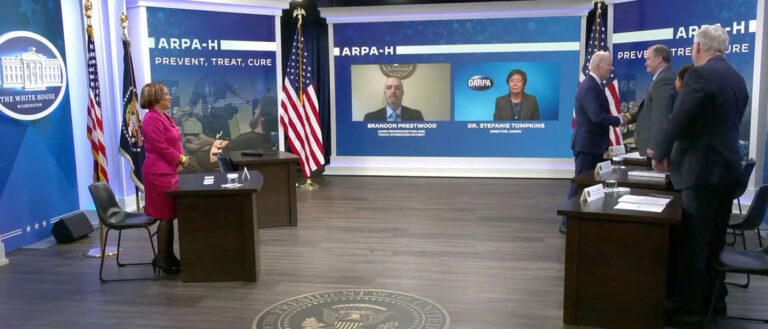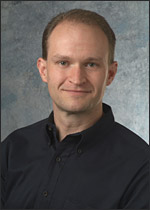
Dustin Tyler invited to White House as part of announcement of new federal agency to push for biomedical breakthroughs
When President Joe Biden on Friday spoke to reporters about the promise of a new federal biomedical research agency, he tapped Case Western Reserve University biomedical engineer Dustin Tyler and a few of the nation's other leading scientists and healthcare experts to join him.
The new entity in question, the Advanced Research Projects Agency for Health (ARPA-H), aims to accelerate breakthroughs to help patients. It is modeled after DARPA (Defense Advanced Research Projects Agency)-the organization credited for contributing to breakthroughs like the internet, GPS and drones. After the public portion of the event, Biden then met privately for about an hour with the experts, as well as a patient using an innovative prosthetic limb that Tyler developed.

"This was truly an honor for me, for Case Western Reserve University and for the (the U.S. Department of Veterans Affairs )," said Tyler, who also is associate director of the Advanced Platform Technology Center at the Louis Stokes Cleveland VA Medical Center. "I really believe the president has a genuine concern and wants to make a difference for people, and this new agency could really move things forward."
White House calling
The opening minutes of the event began with Biden shaking hands first with Tyler and then several other researchers seated at desks in an area known as the South Court Auditorium.
Others in the meeting-either attending in person or connected by video-included former NIH Director Francis Collins, now science advisor to the president; DARPA Director Stefanie Tompkins; Alondra Nelson, acting director of the Office of Science and Technology Policy; and Lisa Cooper, a member of the President's Council of Advisors on Science and Technology and a professor of Equity in Health and Health Care at Johns Hopkins University.
The final guest was Brandon Prestwood, a North Carolina worker who lost part of his arm in an industrial accident in 2012. The prosthetic hand that Tyler and his team developed gives him a sense of touch and pressure.
"When I put the system on and it's working, it makes me complete again," Prestwood said in a story on Cleveland.com. "My mind accepts it as 'This is what my left hand feels like.' It gives me back my sense of being complete."
Tyler said Prestwood's comments at the White House may have been more important than any other talk about the future of technology and healthcare.
"That was the highlight for me-when Brandon was able to speak and to tell them the difference our work had made in his life," Tyler said. "That's what it's all about: helping people be able to do the things they want to do."
Friday's event was the culmination of a whirlwind 24 hours for Tyler, who was attending a conference in California when he got the call to be at the White House for the Friday afternoon event with Biden.
"I was thrilled to be able to talk about the work, but the other main thing I was able to mention was the need to get more people at the table during the development phase," Tyler said. "We're missing a huge component in the way we do this. We often make things from our own perspective, the perspective of the developer, without considering the users at the end of it all. They need to be at the table from the start."
What is ARPA-H?
ARPA-H was officially created by Congress this month, funding the agency with $1 billion over the next three years.
Biden had proposed ARPA-H in 2021 as a biomedical version of the military's DARPA and said Friday that the new agency should have the same ability to take risks.
Biden said ARPA-H would have "a singular purpose-to drive breakthroughs in biomedicine to prevent, detect and treat diseases including cancer, Alzheimer's and diabetes."
He said ARPA-H would "pursue ideas that break the mold on how we normally support fundamental research and commercial products in this country…ideas so audacious that people say 'It just might work if we could only try.' Well, we're about to try in a big way."
Neural Reality and the Human Fusions Institute
That description parallels the kind of innovative work Tyler's done since first arriving at Case Western Reserve as a graduate student nearly three decades ago.
Initially, his work centered on the use of electrodes to activate nerves-which, in turn, could stir muscles stilled by spinal cord injuries or other damaging events.
He then applied that expertise to prosthetics for people who had lost limbs, with support from federal agencies including DARPA and the VA.
Eventually, Tyler turned his attention to developing ways to provide not just movement but sensation: "The perception of touch actually occurs in the brain, not in the hand itself," he said. "So losing the limb is really just losing the switch that turns that sensation on or off."
Highlights in those years included:
- Tyler and his team in recent years have successfully brought the sensation of physical touch to a prosthesis so an amputee could safely pick up his granddaughter and effectively slice a tomato-fundamentally changing the prosthesis from a sporadically used tool to a working "hand."
- Under his direction on Aug. 24, 2020, a Case Western Reserve student touched, felt and held a banana that was 2,300 miles away at University of California, Los Angeles. It was more than just a scientific stunt, but rather a demonstration of the kind of futuristic work Tyler and his team are already doing at CWRU's Human Fusions Institute.
- In the fall of 2021, his team advanced to the semifinals of the ANA Avatar XPRIZE, outlasting half of the original field of 77 entries in the $10 million competition. Along with researchers from CWRU and collaborators from UCLA, Cleveland State University and the University of Wyoming, Tyler showed off the interactive, interpersonal capabilities of an avatar they named "Sensa," a modified version of a commercially available robotic unit from Hello, Robot. "The beauty of this is that now I can put a prosthesis anywhere in the world, and via this 'neural reality' you can have the same sensation for any distance, from anywhere," he said in a 2020 story in The Daily.






